
Last Updated:
The latest monitor from the MOBIUZ lineup comes in the shape of the EX3210U, a 4K 144Hz 32-inch IPS gaming monitor that, on the surface, seems to excel in almost every area.
The new display from BenQ is one of the brand’s most premium options, sporting a wide 98% DCI-P3 color gamut, VESA DisplayHDR 600 certification, fully comprehensive OSD, and low 1ms MPRT response time. That’s pretty much the perfect mix of specifications for a highly imerssive gaming experience in both competitive and single-player titles.
While this monitor seems to be tailored for PC users, it does feature support for next-gen consoles via its HDMI 2.1 and VRR (FreeSync Premium) support.
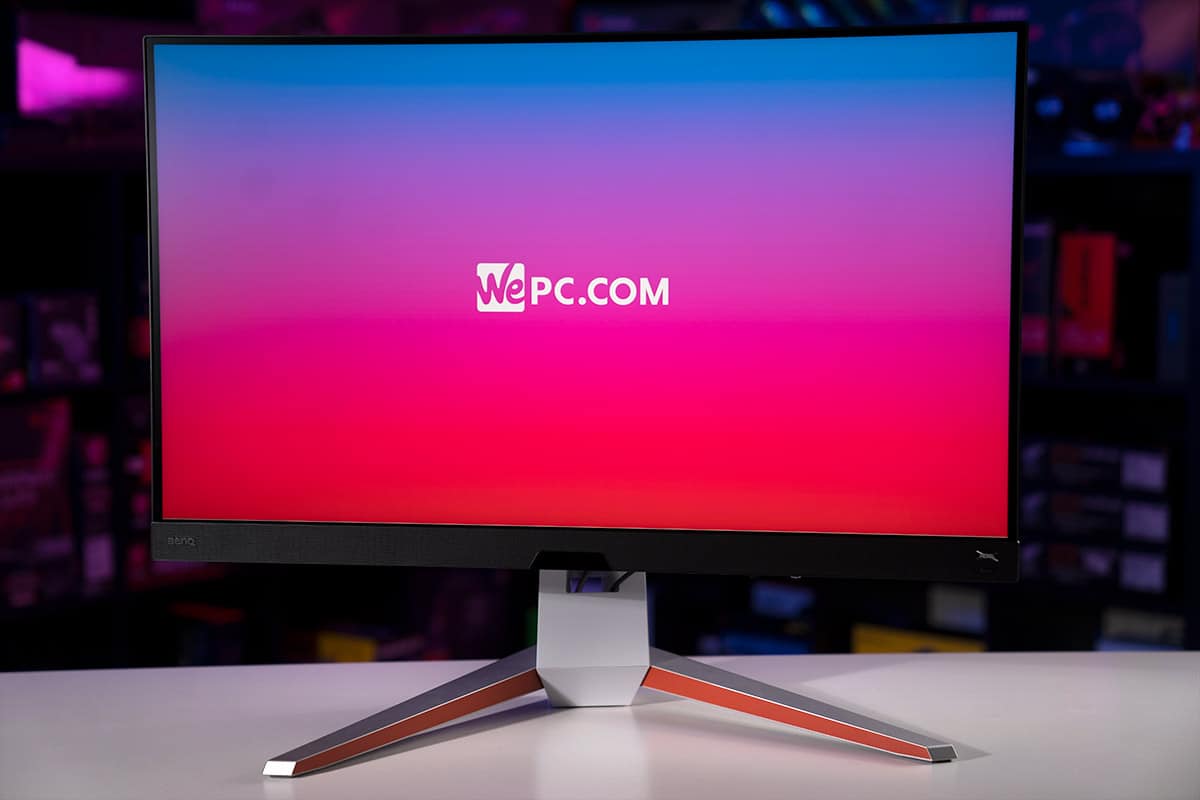
With a tonne of premium 4K 144Hz monitors in today’s market, it’ll be interesting to see how this one stacks up against the market leaders. Like always, we’ll be testing the EX3210U for gaming performance, build quality, aesthetics, picture quality, and color accuracy – concluding with our thoughts of overall value for money.
So, will the MOBIUZ EX3210U be another gaming hit for BenQ or will it struggle to compete in an ever-increasing market? Let’s find out.
BenQ Mobiuz EX3210U monitor: specifications
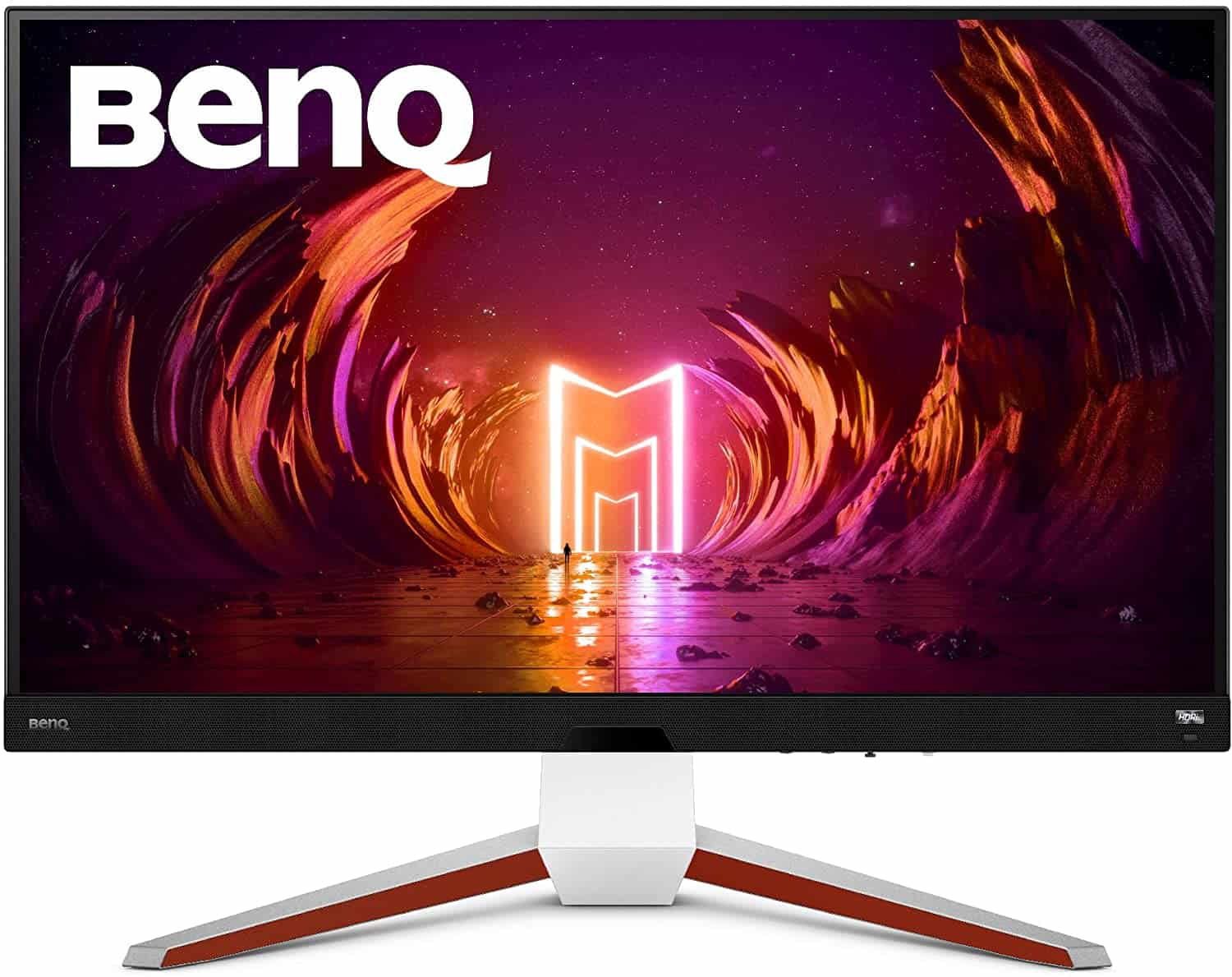

BenQ MOBIUZ EX3210U
98% DCI-P3, 99% Adobe RGB
Pros
-
4K image quality -
IPS viewing angles -
Strong, robust design -
144Hz refresh rate -
Quick response time
Cons
-
OSD buttons feel dated -
HDR is lacking -
Peak brightness is limited
Previous
Next
What’s In The Box
The BenQ MOBIUZ EX3210U comes in a fairly slender box that showcases some marketing material on the exterior. Alongside shots of the panel, we also find several of the monitor’s core specifications and features.
Inside, the monitor is securely packaged inside two large styrofoam pads and wrapped in a thin layer of foam to ensure no damage occurs during transit. User will have to construct the monitor as it does not come assembled. Fortunately, the assembly is incredibly easy thanks to a toolless design. The base of the stand does need to be screwed into the neck, but that can be done via a simple thumbscrew.
Alongside the panel and the stand, users will find the following items:
- BenQ MOBIUZ EX3210U monitor
- Power cable and powerpack (including various regional sockets)
- HDMI 2.1 cable
- DisplayPort cable
- Monitor controller
- USB 3.0
- User manual
- Warranty card


BenQ MOBIUZ EX3210U
Design And Features
With specifications out the way, let’s take a closer look at the build quality, design, and mechanical features the BenQ MOBIUZ EX3210U comes equipped with.
Aesthetic design
The EX3210U follows a similar design path used by the other MOBIUZ monitors, characterized by large, angular features that certainly catch the eye upon unboxing. The large V-shaped stand can be seen protruding from the underside of the large bottom bezel that plays host to the panel’s 2W speaker system. BenQ has equipped the inside edges of the stand with an orange inlay, giving the EX3210U a refined look that is certainly unique in today’s market.
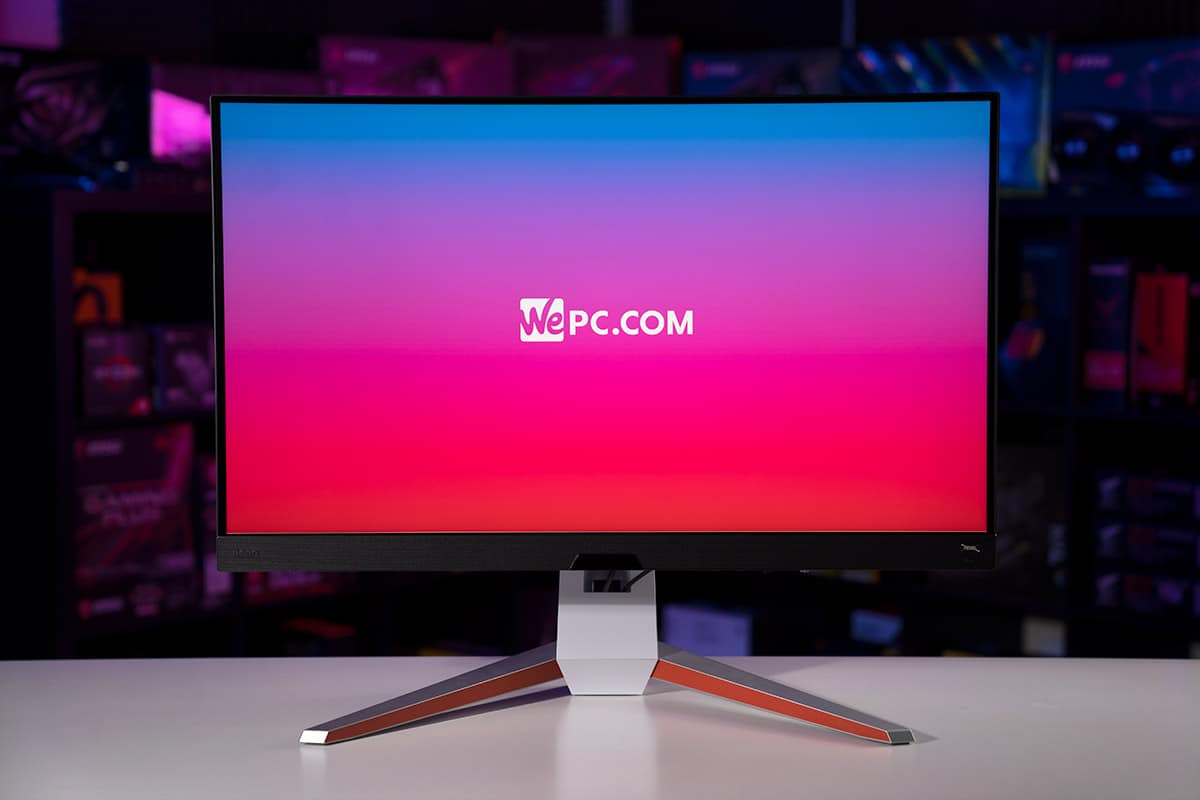
That said, the face of the monitor is relatively business-like, showcasing slim bezels and some subtle BenQ branding on the bottom left-hand corner. An HDRi button can also be found on the bottom bezel, allowing users to toggle through the various HDR features. Finally, a light sensor can be seen in the center of the bottom bezel, allowing the monitor to detect ambient light and adjust the screen brightness accordingly.
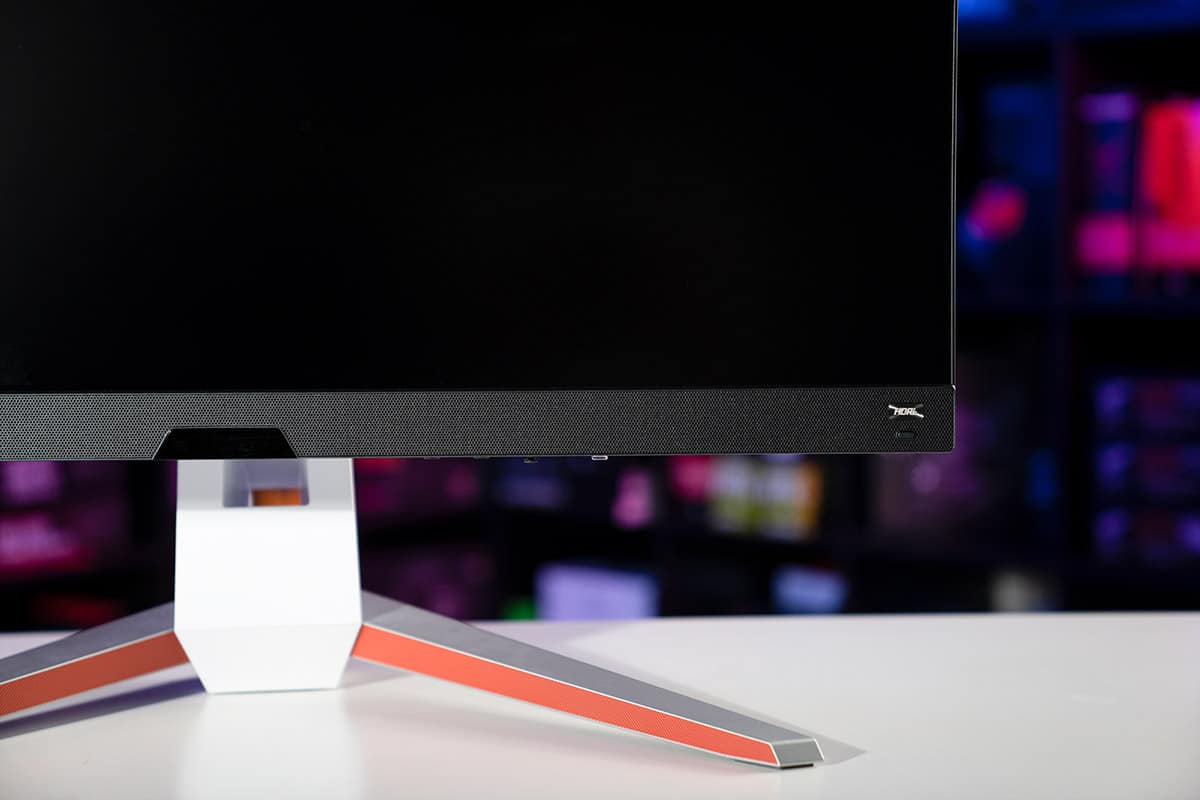
Moving to the rear of the monitor is like night and day when compared to the front. The relatively basic black design turns into a vibrant white canvas clad with RGB strips on the diagonal. Another speaker grill can be found in the centre of the monitor on the top edge, with MOBIUZ branding seen on the left-hand side as you look at the rear. Cable management options are available at the base of the stand via a simple cutout.
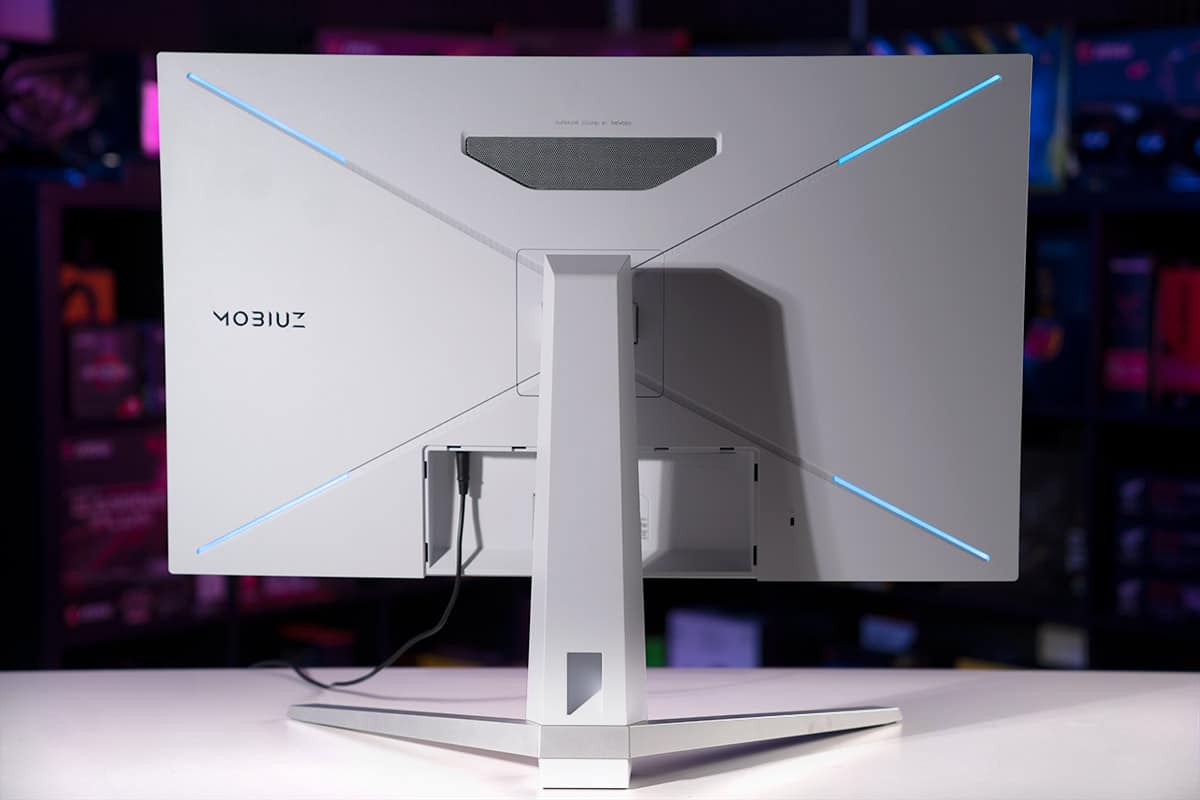
Overall, while this isn’t the most attractive-looking monitor we’ve ever reviewed, it certainly isn’t the worst either. This bespoke design seems to meet the requirements of both business and gaming scenarios.
Build Quality
While the design of this monitor will be debated long and hard, one area that we can’t argue with is the build quality. This monitor feels absolutely rock solid from top to bottom – a big relief when you consider the price it lists for.
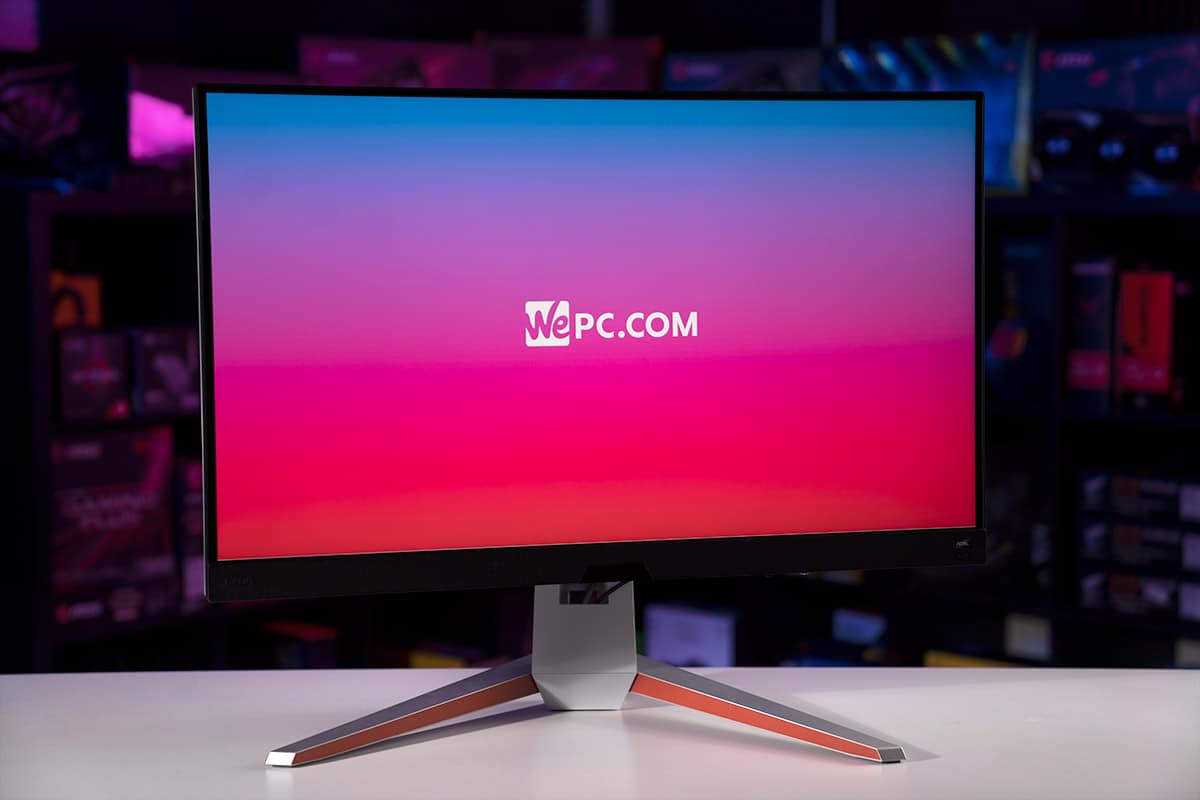
All fittings and fixtures feel incredibly secure and well-finished, with general adjustments feeling purposeful and firm. That said, there is a little bit of play when adjusting the height of this monitor, but nothing too strenuous.
The panel itself uses an anti-glare matte coating which is incredibly robust, adding another layer of protection where it’s needed most. Plenty of metal has also been used throughout the design of this monitor, giving the entire thing a relatively premium feel.
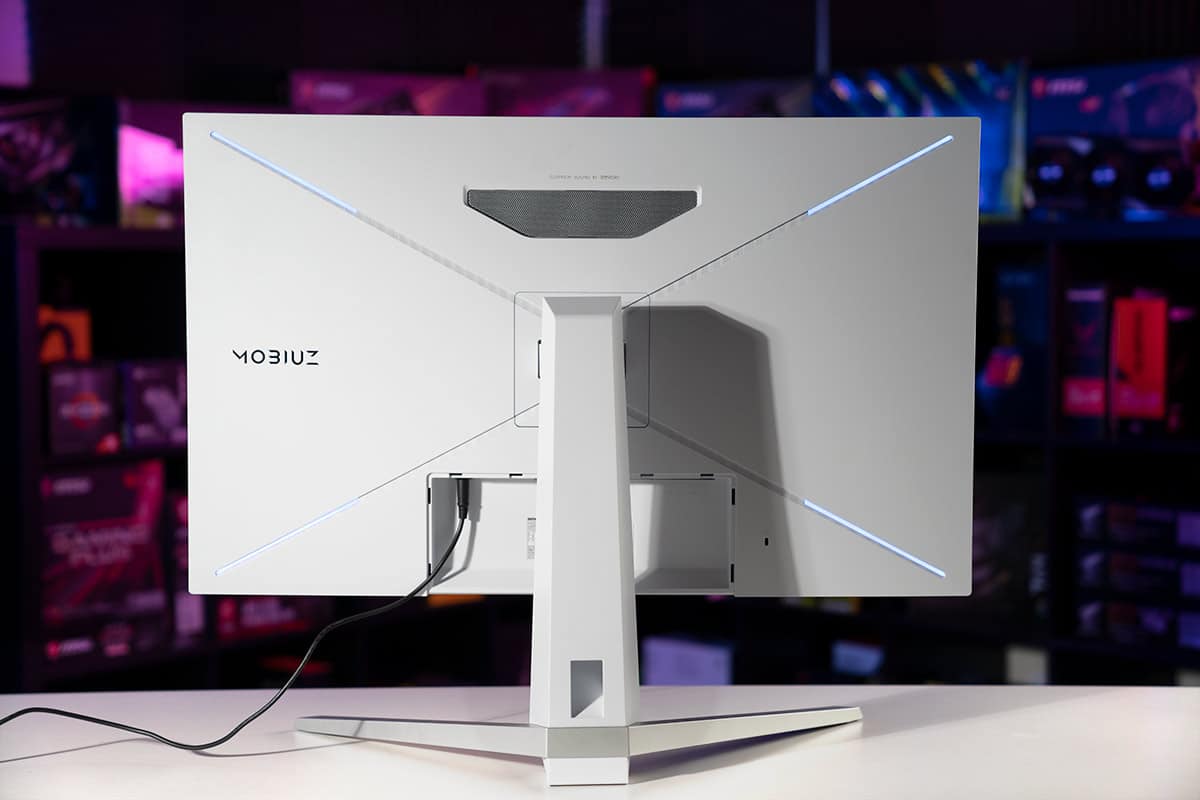
As with most modern monitors, the EX3210U’s stand does feature a predominantly plastic exterior. However, that plastic feels very hardy and robust, unlike some of the other premium offerings we’ve had the pleasure of testing.
My only gripe as far as build quality is concerned is the OSD buttons found on the underside of the bottom bezel. They feel a little flimsy and could have been produced a little better. Apart from that though, a solid feeling monitor.
Panel Coating
As we just said, the EX3210U features an anti-glare matte coating that does a great job of mitigating most natural and manmade light sources. Of course, reflections do occur when using this panel near a particularly strong light source. However, for the most part, it performs pretty well.
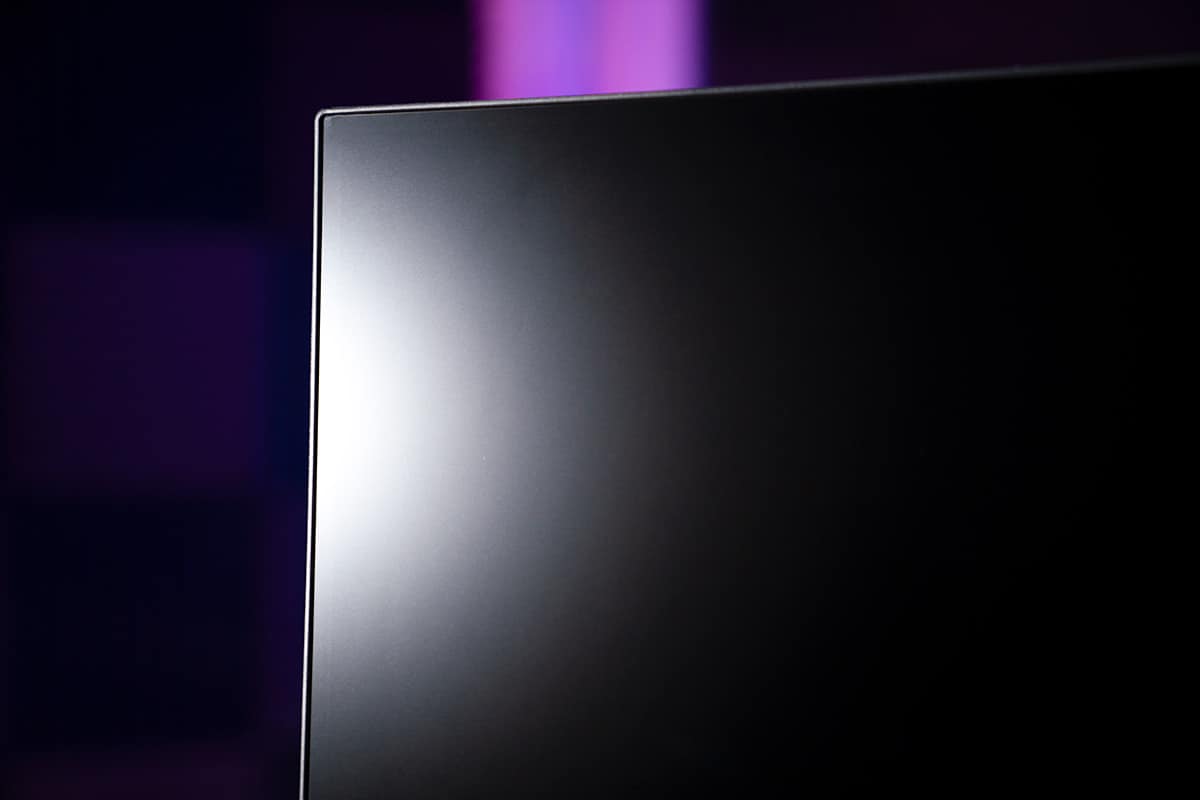
Like all anti-glare matte panels, the EX3210U can pick up fingerprints relatively easily. Fortunately, a simple cleaning cloth and solution should see to those issues relatively quickly.
Bezels
The bezels on this monitor aren’t the slimmest we’ve ever seen, however, at 8mm sides and top, they do equal most of the 32-inch monitors in today’s market. That said, the bottom bezel is far larger, measuring in at 37mm. This is mainly due to the large 2W speaker system that resides in this section of the monitor, producing above-average sound quality when compared to alternative monitor speakers.
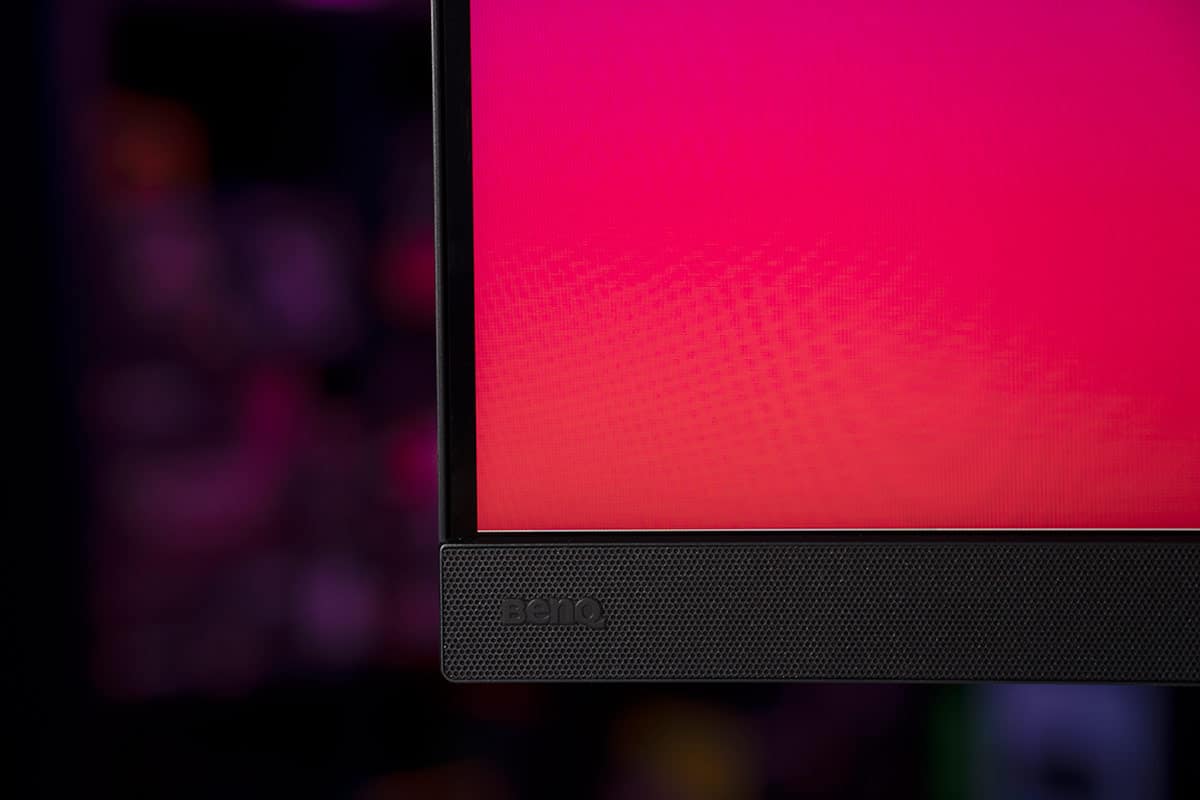
Stand
As far as stand adjustments go, the EX3210U provides almost all the adjustability you could want from a monitor. With height, tilt, and swivel functionality, users can find a comfortable viewing position when using this monitor. Unfortunately, the EX3210U doesn’t offer pivot functionality – making cable insertion a little more difficult.
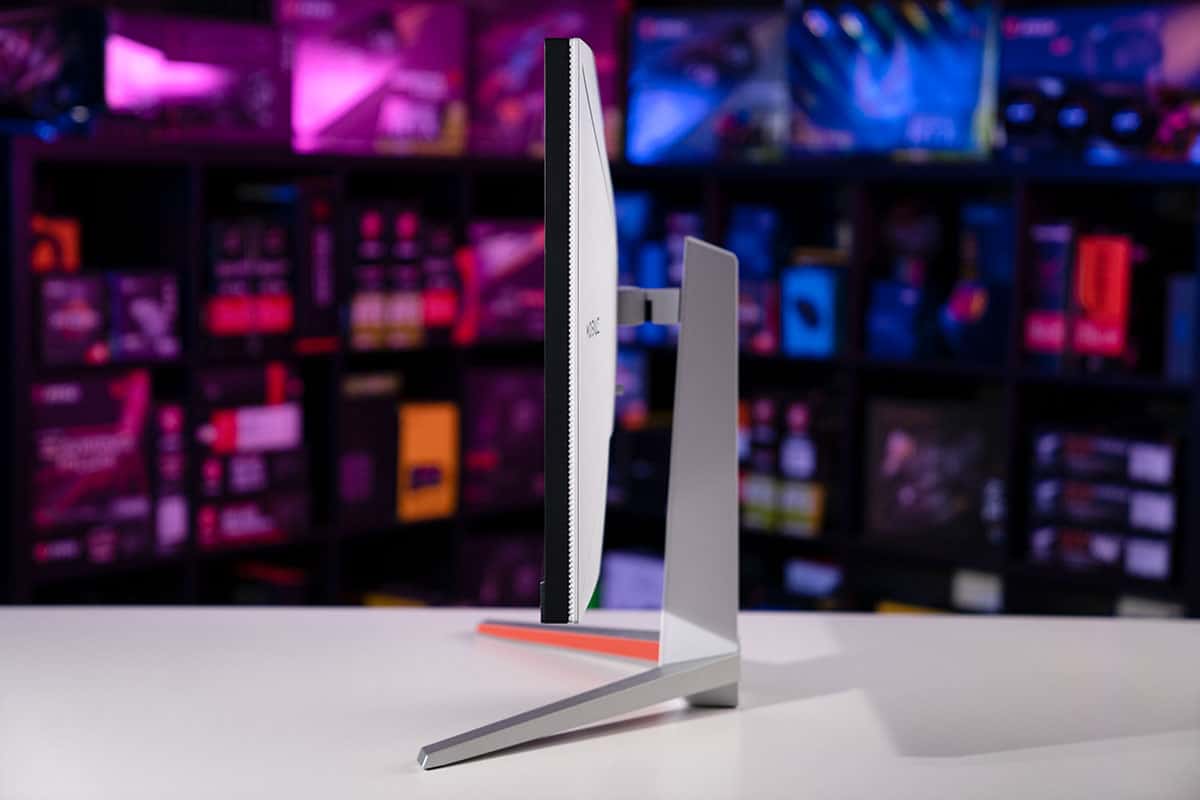
Below are the full adjustments available with this particular panel:
- Forward Tilt – 5 degrees
- Backward Tilt – 15 degrees
- Left Swivel – 15 degrees
- Right Swivel – 15 degrees
- Pivot – N/A
- Height – 100mm
Like most modern gaming monitors, this panel also allows for simple VESA mounting – via a 100 x 100mm bracket.


BenQ MOBIUZ EX3210U
Inputs
Like most modern monitors, all inputs for the EX3210U can be found at the rear of the monitor. Cables are inserted in the usual vertical fashion, with small symbols on the rear of the panel used to locate the specific inputs.
The BenQ MOBIUZ EX3210U does feature an I/O shield for the inputs – allowing you to maintain desk tidiness if the rear of the monitor is visible.
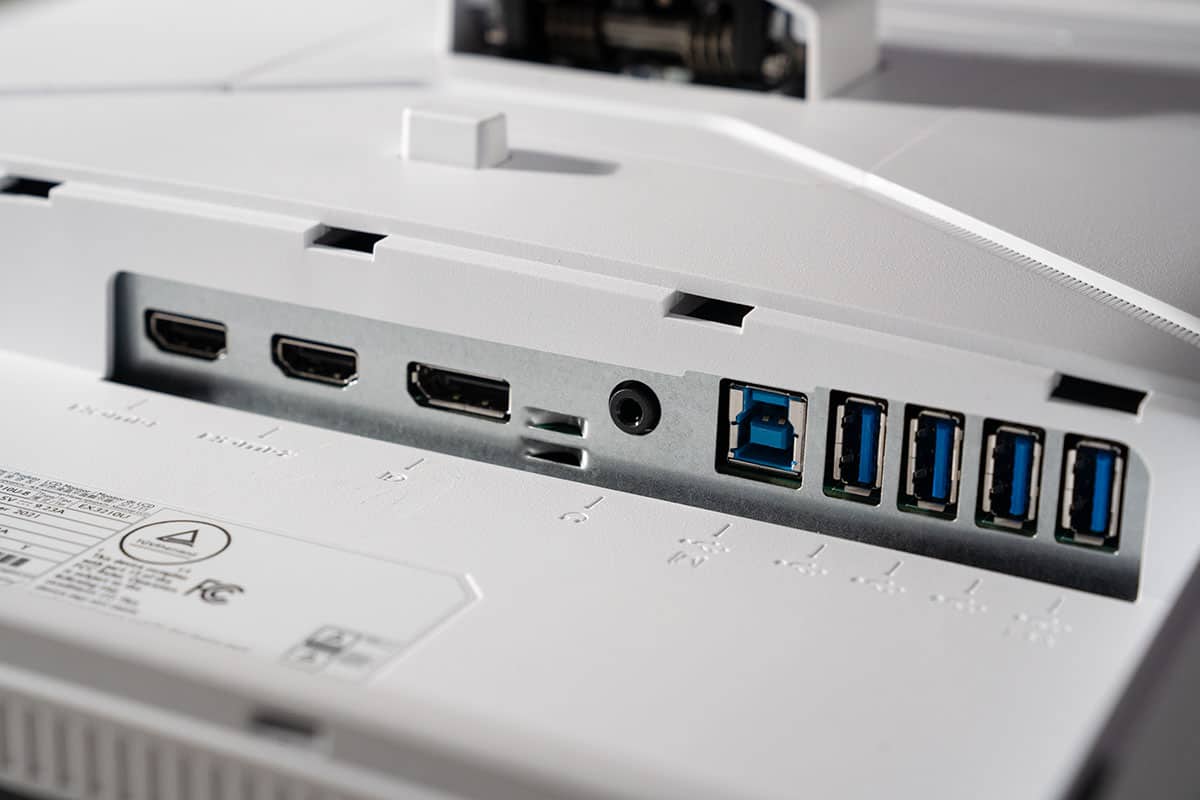
The big plus of this panel is that, alongside it’s 4K 144Hz panel, it also features HDMI 2.1 certification. This allows the monitor to deliver [email protected] gameplay from next-gen consoles such as PS5 and Xbox Series X.
Better yet, it features 2 x HDMI 2.1 ports, meaning you won’t have to chop and change cables to get the full potential of this monitor.
Alongside this, users will also find a number of USB ports, 1 x DisplayPort, 1 x USB Type B, and a 3.5mm headphones jack.
OSD
While the OSD navigation on the EX3210U might feel like the old-age buttons of yesteryear, BenQ has in fact used the much easier and more beloved joystick that so many other monitor manufacturers have started to implement. Alongside the main joystick, there are several quick buttons for accessing various menus within the OSD – all of which can be selected in the OSD itself.
All being said, there are plenty of options within the OSD for fine-tuning the visual experience to your exact needs. However, unlike other montiors, users must first first select a ‘Color Mode’ before making any more adjustments.
Visual adjustments for this monitor include picture quality, Black eQualizer, Light tuner, Color Vibrance, Brightness, contrast, sharpness, B.I+, Color temp, AMA, Blur reduction, and a reset switch.
Previous
Next
Color Accuracy & Picture Quality
We like to test each monitor we review for color reproduction to see how it would perform in color-sensitive situations. Despite this monitor being tailored towards gamers, it features a wide color gamut (98% DCI-P3 according to specs) which means both accuracy and HDR performance should be relatively decent.
Like always, we started off the color accuracy testing section of this review by loading up our colorimeter and running a test right out of the box.
Below are the results.
As you can see from the results above, the EX3210UI didn’t offer the best colors right out of the box. We recorded a 6997K white point, 0.30 cd/m2 black depth, and 2.34 gamma in the panel’s factory settings. Even more concerning, however, was the below-average 3.98 average deltaE – delivering poor accuracy on a small color palette. Additionally, the contrast of the monitor only ran at around 815:1, almost 20% lower than the marketed 1000:1 that IPS monitors are known for.
We quickly moved onto the pre-calibrated sRGB emulation preset expecting far better accuracy than what was shown from ‘out of the box’. We ran the same color test and overall accuracy was greatly improved. Again, we recorded a 6928KK white point and 0.32 black depth in this mode – a little disappointing if truth be told.
That being said, the average DeltaE did decrease to a worth 0.85 average across a large color palette. While this isn’t the best we’ve ever recorded, it is good enough for some light editing and content creation.
At this stage, we decided to throw the panel through a deep calibration to see what levels of accuracy we could produce. For best results, we altered the sRGB values to 99/91/97.
Looking at the results, improvements were certainly made across the board once calibration had completed. White point was now a perfect 6499K and black depth was at an all-time low (0.14cd/m2). Contrast did take tank a little bit, but that’s fairly common when calibrating a panel for the sRGB color space. Average deltaE was recorded at 0.64 with a maximum DeltaE of 5.31 – a little underwelming considering the panel type and cost of this monitor. Gamma did read 2.2, however.
Panel Uniformity
Panel uniformity is a test we run to check how uniform the luminance and colors are across the entirety of the screen. During this test, the center square is used as the reference space. Every other square is then tested to see how far it differentiates from the reference.
In an ideal world, we want every square to be green, meaning it hasn’t broken the differential threshold – something we can set at the start of the test.
Note: results will differ from panel to panel.
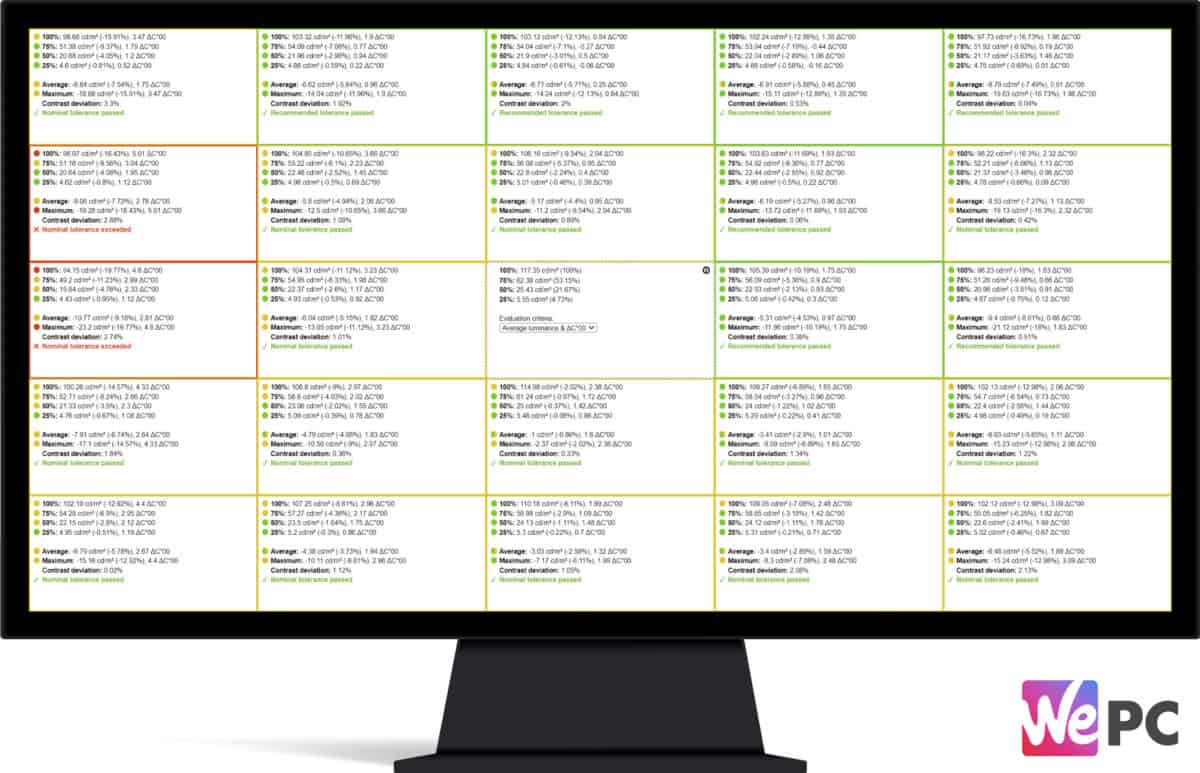
The panel uniformity for the EX3210U model we received was above average, only showcasing a couple (top left) red segments – exceeding the nominal tolerance set by the colorimeter.
The majority of the segments passed the nominal tolerance, albeit only just, delivering decent panel uniformity when watching sporting events or programming with large blocks of solid color.
Backlight bleed results:
As for backlight bleed, we ran a black image through the monitor with all the lights off – as seen below. The results were pretty good all things considered, with only limited levels of light bleed found on the bottom edge of the screen.
See image below for reference:
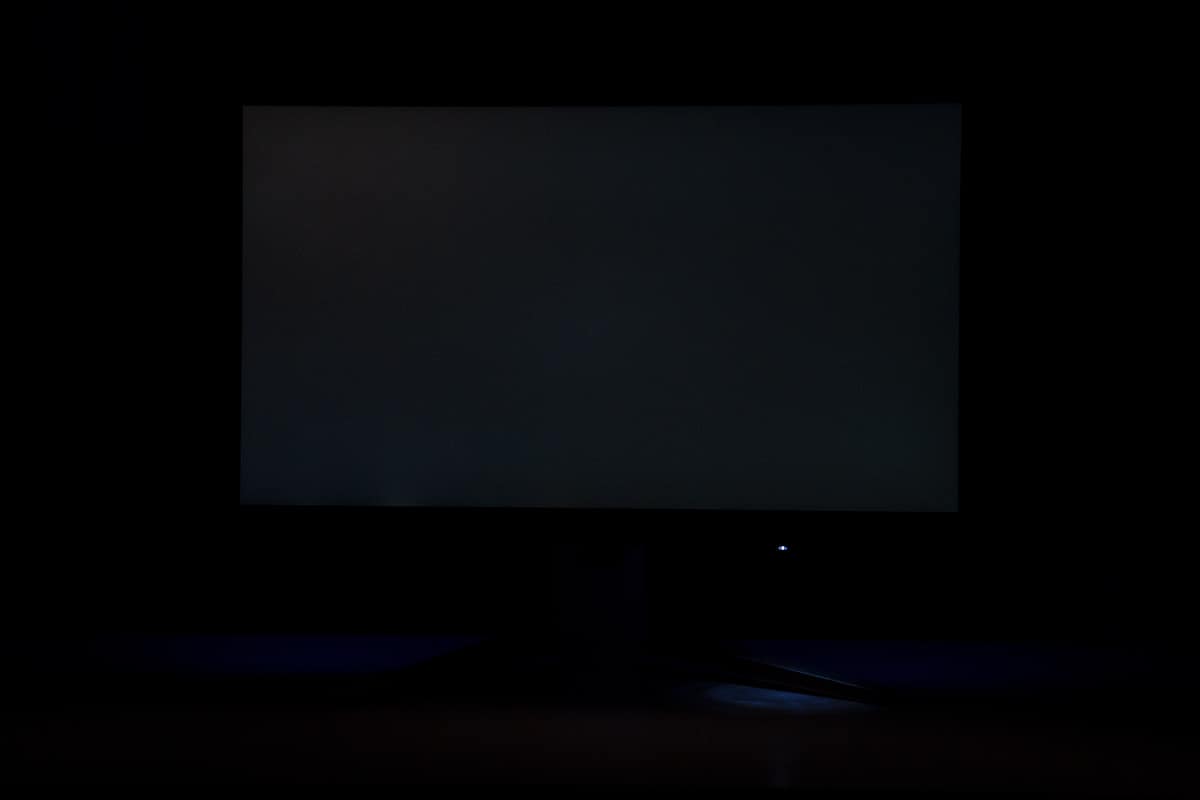
Viewing Angles
Like most IPS panels, the BenQ EX3210U delivered excellent viewing angles thanks to the panel technology found at its core. As you can see from the video below, we only saw slight color shifting at obscure angles, making the monitor a great choice for individuals that enjoy playing with other players.
Below is a full view of the viewing angles of this monitor.


BenQ MOBIUZ EX3210U
Color Gamut
As part of the calibration process, the DisplayCal will give an accurate measurement of the color gamut the monitor can provide. Below are the results of the color gamut test:
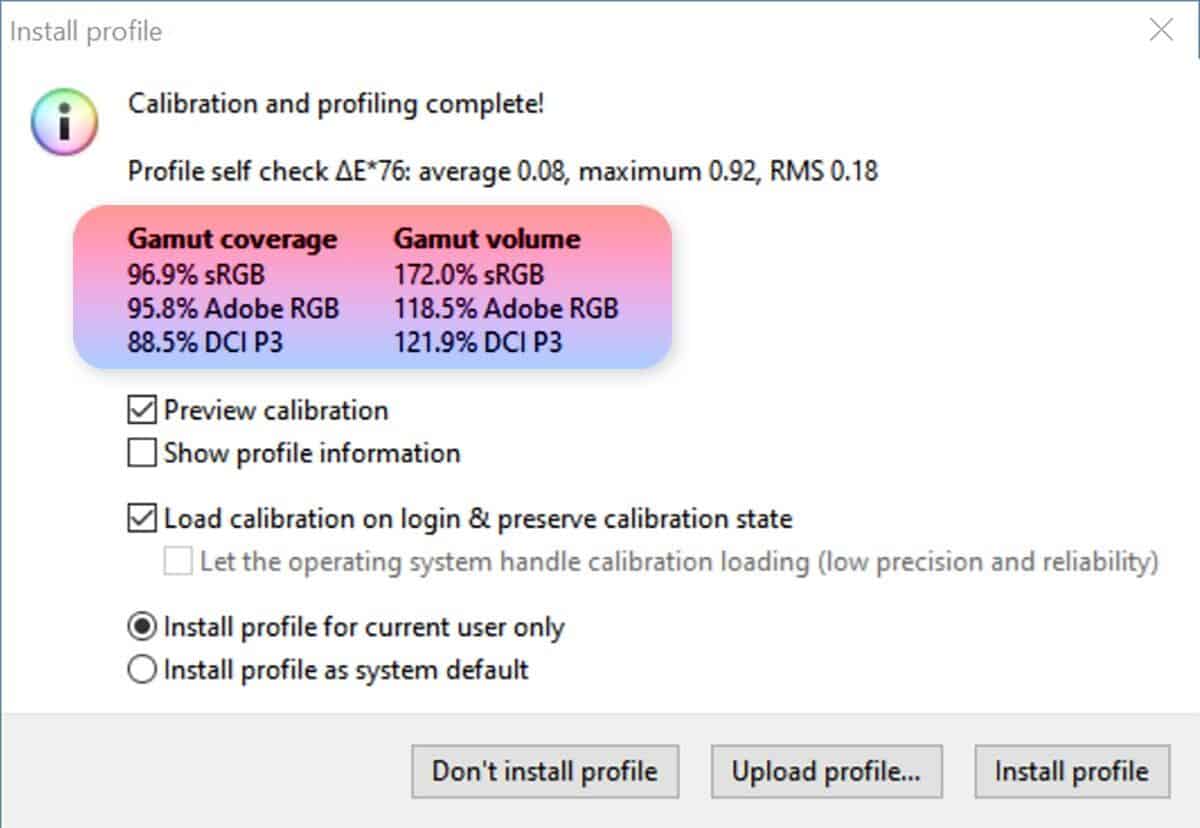
Unfortunately, the unit we were sent didn’t quite live up to the specifications published on the brand’s website. BenQ state the EX3210U should deliver a 98% DCI-P3 coverage. While it does exceed that in volume, it doesn’t quite produce the relevant coverage – only offering 88.5% of the respective gamut.
Previous
Next
Above we’ve included the physical graphs for each color space, showcasing the exact coverage we recorded in the DCI-P3, Adobe RGB, and sRGB color spectrums. On each graph, you can clearly where the EX3210U exceeds (or falls short) of the specific color space.
Maximum And Minimum Brightness
We ended the color accuracy and picture quality testing by checking the maximum brightness, minimum brightness, and 120 candelas level on this panel. The results are below:
| Brightness | Candelas |
|---|---|
| 100 Brightness | 283.44cd/m2 |
| 0 Brightness | 54.75cd/m2 |
| 28 Brightness | 120 cd/m² |
BenQ Mobiuz EX3210U monitor: Gaming Performance
With color accuracy and panel uniformity out of the way, it’s time to put the BenQ MOBIUZ EX3210U through a number of different gaming and response tests to see how it stacks up in gaming scenarios. Like always, we’ll be testing the monitor across a variety of games to get a greater understanding of how this monitor performs overall.
For this portion of the testing, we enabled VRR, set the refresh rate to its max 144Hz, and tested all of the available response time settings in the OSD.
Competitive gaming
We began the gaming portion of the review by throwing the EX3210U into a couple of competitive gaming scenarios – mainly CS:GO, COD, and PUBG. This should give us a pretty good indication of just how responsive this panel is, with response time artifacts visibly obvious in all. Better still, as players can actually benefit in these games from higher refresh rates, it’ll be interesting to see just how smooth this immersion-based monitor is in more demanding titles.
Playing CS:GO on this monitor felt pretty damn good. I mean, we were impressed, to say the least. Character models looked crisp, motion felt smooth, and image quality looked absolutely fantastic. It really was quite a pleasant gaming experience – something you can’t always say when reviewing 4K monitors in these types of games.
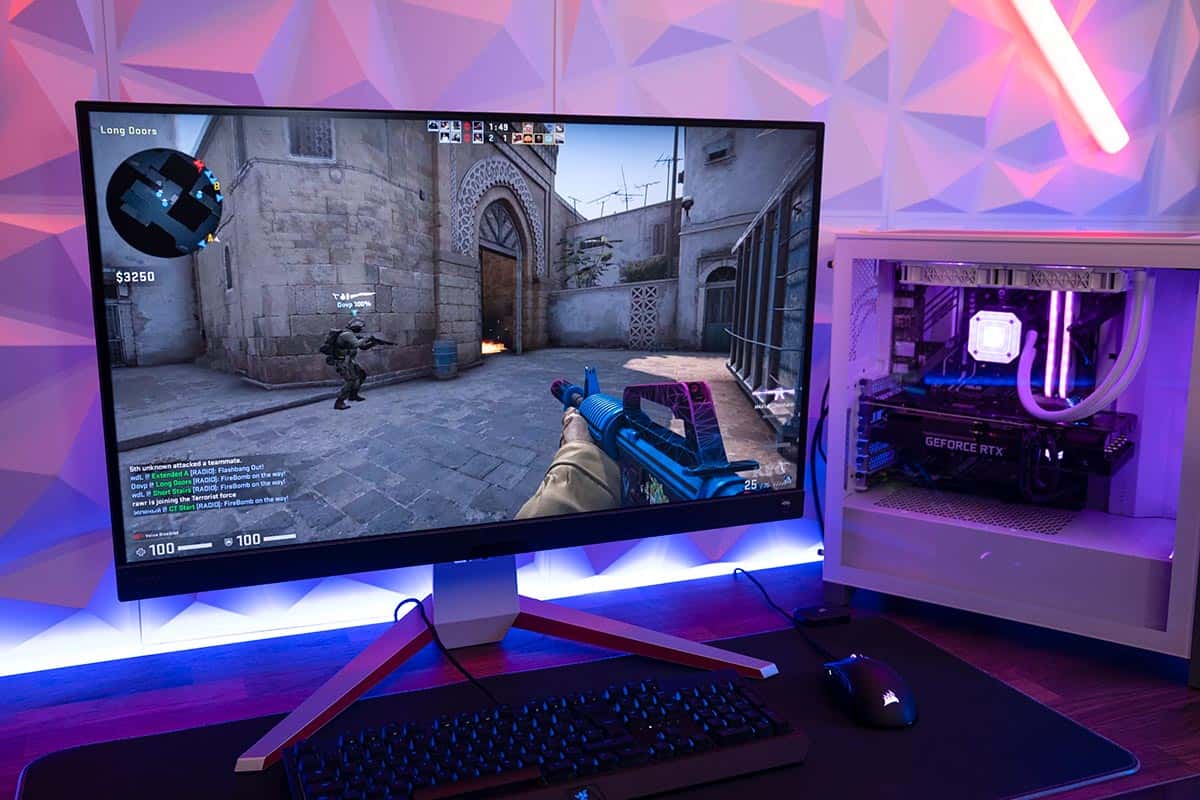
While there was some ghosting and blurring visible, it wasn’t nearly as much as we were expecting. For the most part, perceived blur was pretty good – with fast-moving objects easy to track and hit. Edges of buildings, doorways, and other structural parts of the map all felt sharp and precise – even when strafing from side to side. Of course, no screen tear was detected during the competitive gaming section of this review – mainly thanks to the VRR (Variable refresh rate) support this monitor comes equipped with.
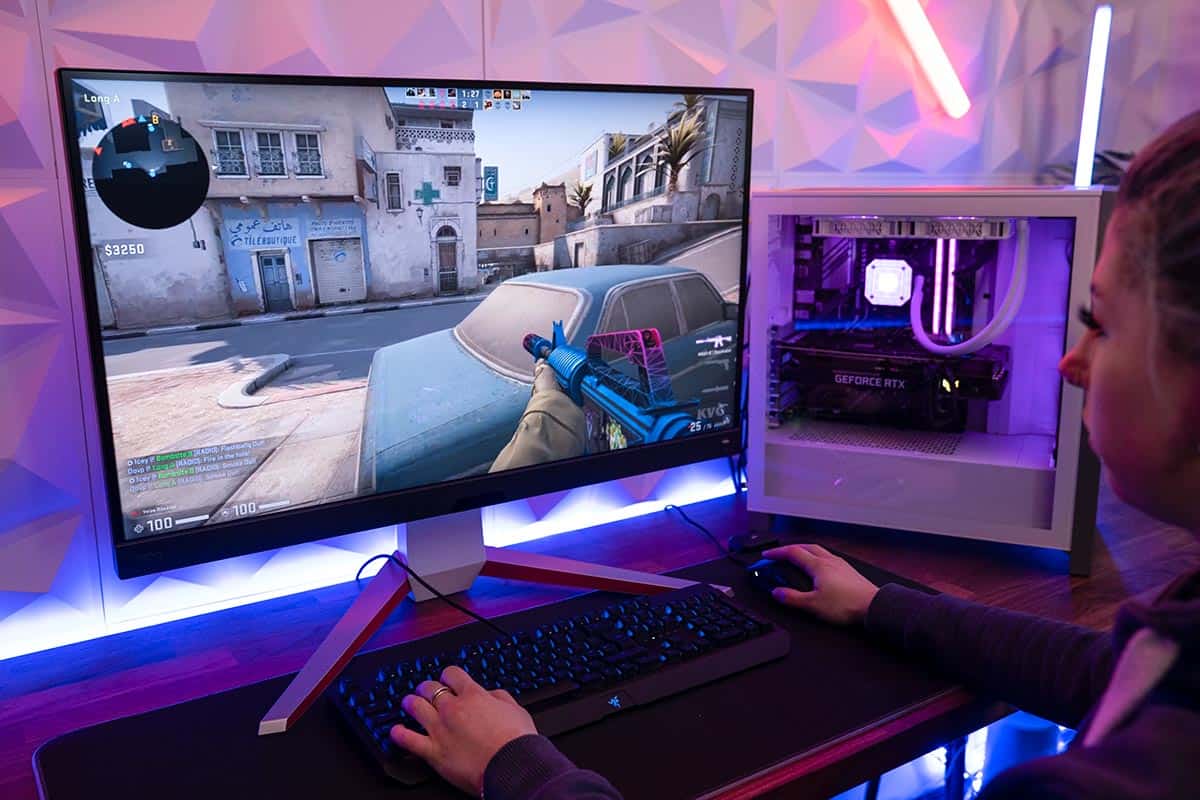
Response time aside, it’s worth noting just how good the actual image quality was when playing these titles. While 4K screen resolution isn’t the ideal setting for competitive play, it certainly adds a level of immersion to the game that can’t be discounted. All three titles looked absolutely superb.
At this stage, we played around with some of the various overdrive (AMA) and Blur Reduction features of this monitor. The results were varied, but overall, again, we were quite surprised. Using the blur reduction feature would increase the image clarity of moving objects via black frame insertion. While it did make moving objects look more accurate, it did reduce the overall brightness quite a bit. We cranked the AMA (Advanced Motion Acceleration) feature up and, similar to overdrive, some overshoot could be seen. That being said, even at the maximum setting, overshoot wasn’t nearly as bad as some of the other monitors we’ve tested.
Overall, pleasantly surprised with how the BenQ EX3210U performed in competitive games.
General gaming
At this stage, we decided to throw the EX3210U through a few less-intensive titles to see how it performed from an image quality standpoint.
Shadow of the Tomb Raider was the game of choice and, as expected, it looked absolutely exceptional. The large 32-inch screen size was a great canvas for high levels of visual immersion, pairing nicely with the crisp, vibrant colors provided by its wide color gamut (98%DCI-P3). General image quality also looked incredibly sharp thanks to the 4K screen resolution at its core – delivering excellent sharpness and clarity.
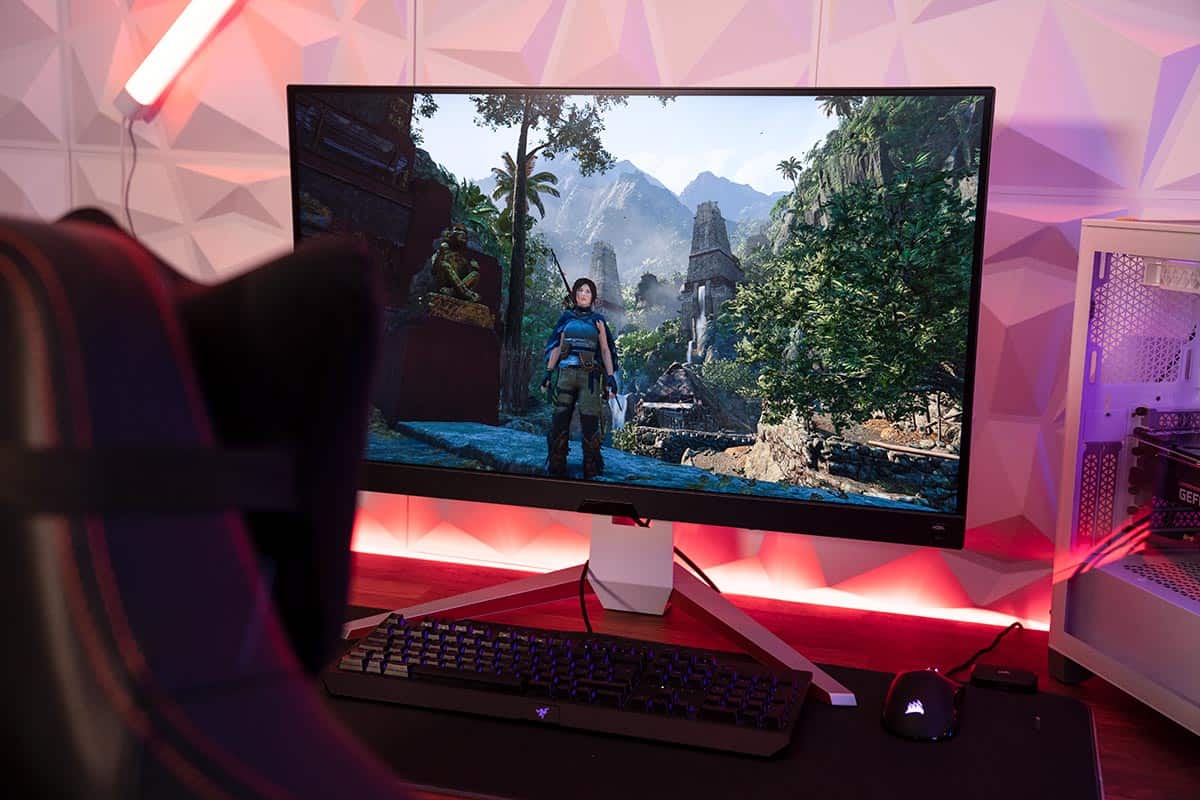
We launched the monitor’s HDR setting – of which there are several modes – and performance was average at best. Granted, the monitor only offers VESA DisplayHDR 600 certification, so we weren’t expecting anything too substantial. That said, only limited levels of detail were found in extreme dark and light spaces.
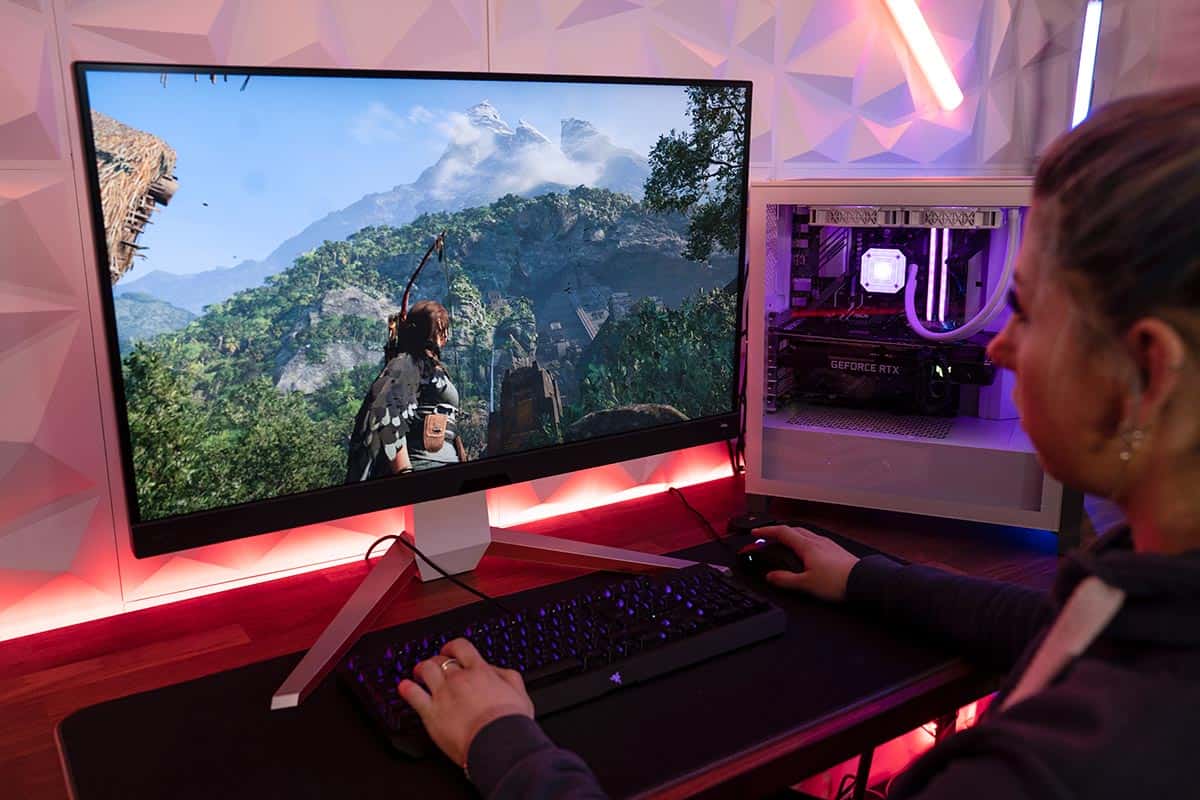
Don’t let that take anything away from this panel’s performance though – it really did excel when playing a variety of single-player games. This monitor is clearly tailored for these types of games, offering up excellent performance, visuals, and overall enjoyment.
Blur Buster UFO test
Concluding the gaming performance tests, we ran the monitor through the BlurBuster UFO test. This test is a fantastic way of quickly seeing the motion clarity of moving objects and general perceived blur. We tested all the monitor’s main response time features on the max refresh rate available – which for this panel is 144Hz.
Below are the results:
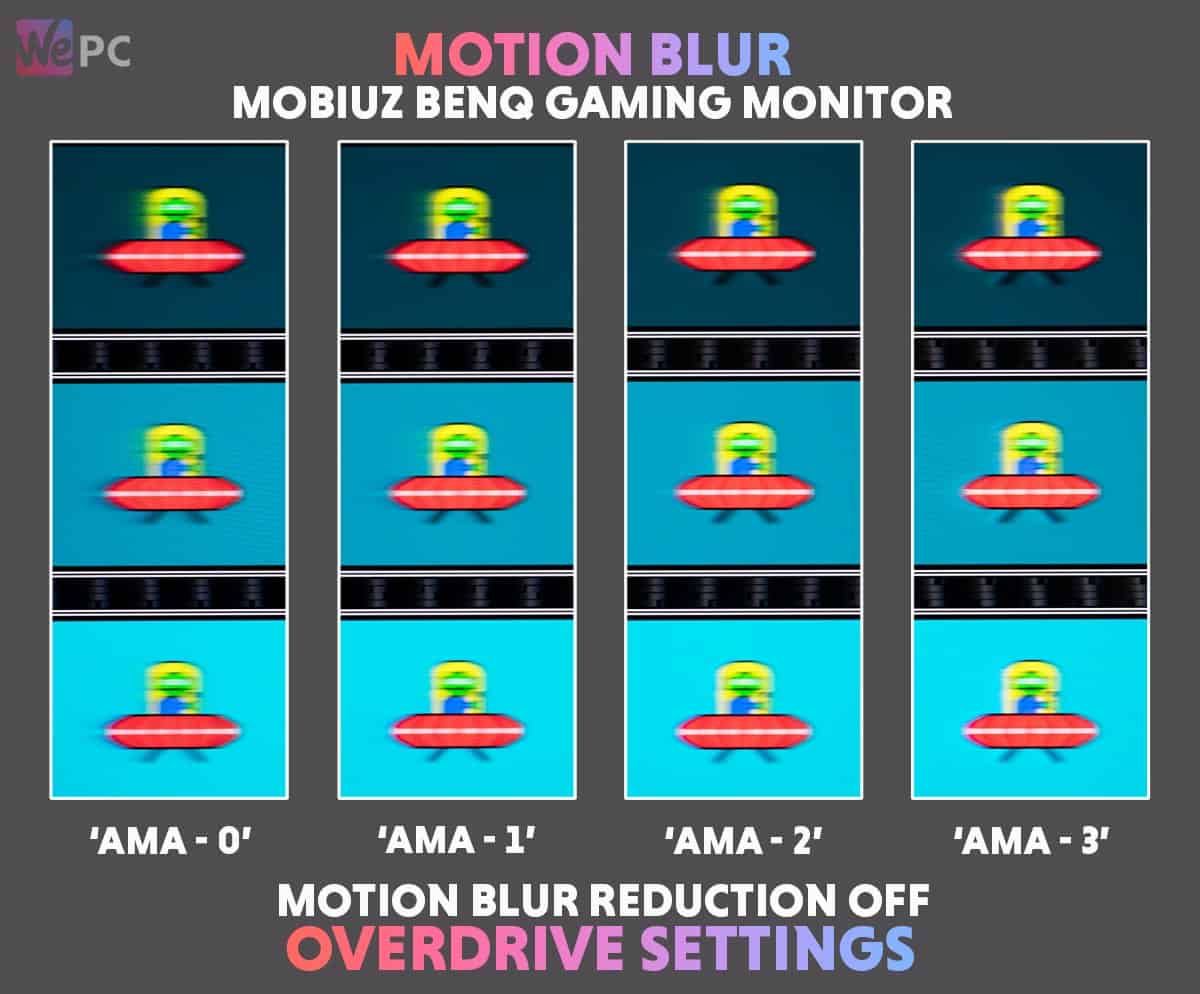
The first set of tests were run using the monitor in ‘FPS mode’. We cranked the AMA setting up to its maximum value to see how it performed.
As you can see, AMA 2 seemed to offer the best balance between image quality and responsiveness. The alien definitely became sharper at this stage, without introducing that annoying overshoot that you can start to see creeping in on AMA 3.
AMA 0 and 1 were both fairly similar, with AMA 1 offering a slight improvement in image quality.
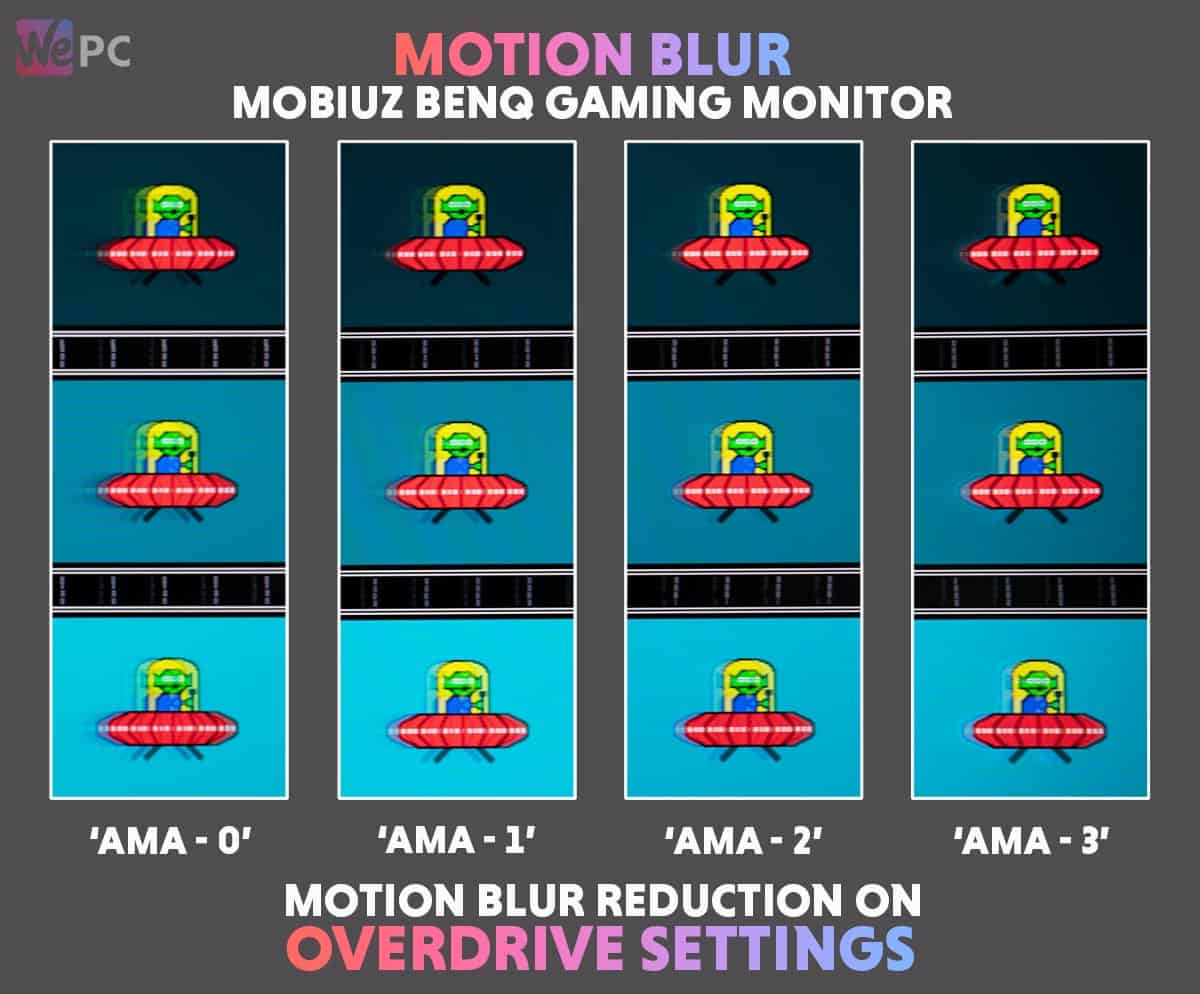
That being said, we have to applaud the image quality of this test – especially when you consider it against some of the market’s other 4K 144Hz monitors. If you’re looking for peak clarity in competitive games, MBR and AMA 3 were the best results. However, for everything else, we’d recommend AMA 2 as a general all-round setting.
Final Thoughts
So, there you have it, our comprehensive review of the BenQ EX3210U – another high-end 4K 144Hz gaming monitor. Overall, we were incredibly impressed by this monitor, especially when it came to general image quality and motion clarity.
The 4K 144Hz monitor from BenQ’s MOBIUZ line certainly seemed to excel in most areas – even some competitive settings. Unlike other monitors of this ilk, the EX3210U delivered great gaming performance over a variety of different genres – producing fantastic levels of immersion throughout.

The comprehensive OSD allows you to not only completely customize the visual experience to your exact needs, but also allows you to save profiles and set hotkeys for greater ease of use. A fully adjustable stand has been utilized for this monitor and build quality feels incredibly well-made. Styling may be a little hit and miss, but it certainly adds something different to a market that seems to stick to the same rough template.
Overall gaming performance was excellent for this monitor, with picture quality, color accuracy, and general motion handling feeling very premium. Ultimately, we really enjoyed using this monitor – something I didn’t intially think I’d say upon unboxing (no disrespect BenQ). For us, it’s one of the better 4K 144Hz monitors in today’s market, offering up pretty good vlaue for money when all things considered. Yes, it may not have the latest OLED or mini LED technology, but it still manages to perform highly in almost any scenario.






